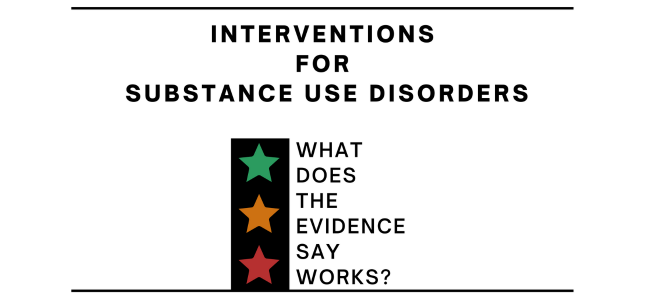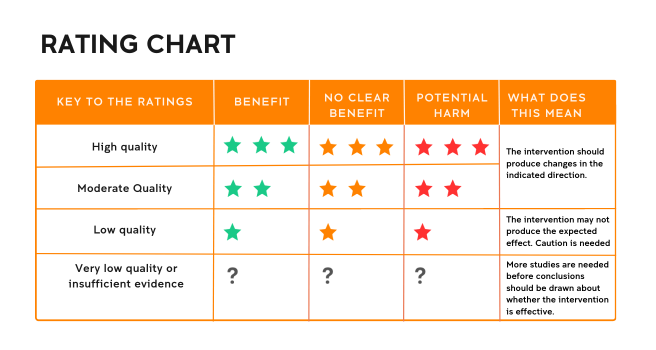
Understanding what interventions work is critical to provide treatment and other services to people who use drugs. But it is often hard to find the time to read all the research and understand what it means. To help, we’ve put together the latest evidence available to support different interventions for substance use disorders.
Focussing on interventions for cannabis, stimulant and opioid use disorders, we have extracted “evidence statements” from the latest systematic reviews of randomised controlled trials. The quality of each is rated using the key below. The number of stars indicates the quality of the available evidence (based on Cochrane GRADE criteria). The colour of the stars indicates whether the intervention is beneficial (green), neutral (orange) or potentially harmful (red).

Evidence statements
Cannabis use disorders
Stimulant use disorders
Opioid use disorders
Interpreting the evidence
These evidence statements only include evidence synthesised in systematic reviews of randomised controlled trials published up until March 2021. They do not include evidence from single studies or evidence derived after this date.
Things to consider when interpreting the evidence statements:
- The quality of evidence does not reflect how much impact an intervention will have, or whether it will be beneficial (e.g., there may be high quality evidence that an intervention has a small benefit or no benefit).
- Low quality ratings do not mean that an intervention does not work, but rather that it has not yet been adequately evaluated.
- Each evidence statement is based on a different set of studies, and therefore they cannot be directly compared.
- Not all available evidence is included. There may be good evidence available to demonstrate the benefits of an intervention; however, it was not from a randomised controlled trial or was not synthesised in a systematic review.
Further information
This webpage is based on a technical report published by the National Drug and Alcohol Research Centre, University of New South Wales. You can access the full technical report here. We urge readers to refer to the original review papers and studies cited in this report to get a clearer picture of a given intervention’s impact.
Acknowledgement
This research was conducted as part of a project funded by the European Monitoring Centre on Drugs and Drug Addiction (EMCDDA), European Union. We would like to thank staff at the EMCCDA for their expert opinions on the data collection and analysis methods. The views expressed here do not necessarily reflect those of the European Union or the EMCDDA

